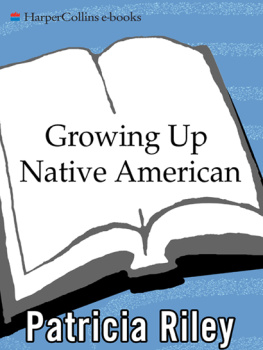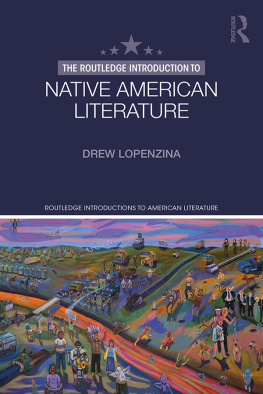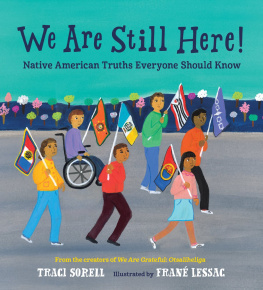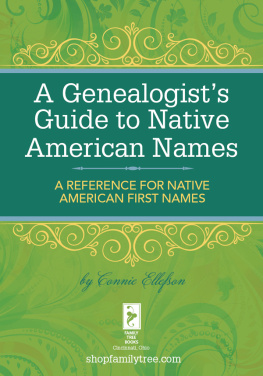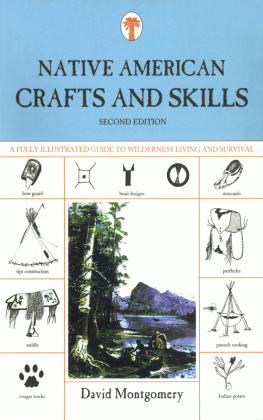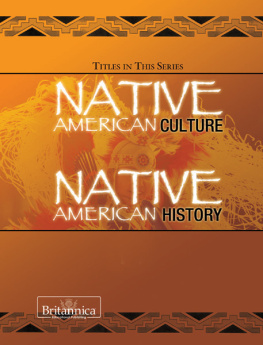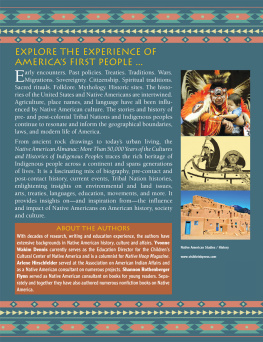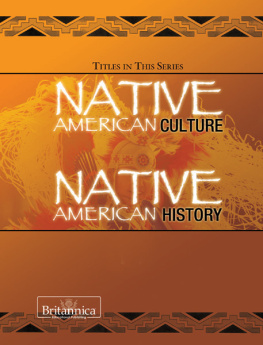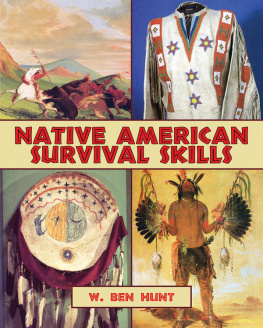Adler Bill - Growing Up Native American
Here you can read online Adler Bill - Growing Up Native American full text of the book (entire story) in english for free. Download pdf and epub, get meaning, cover and reviews about this ebook. year: 2014, publisher: HarperCollins e-Books, genre: Home and family. Description of the work, (preface) as well as reviews are available. Best literature library LitArk.com created for fans of good reading and offers a wide selection of genres:
Romance novel
Science fiction
Adventure
Detective
Science
History
Home and family
Prose
Art
Politics
Computer
Non-fiction
Religion
Business
Children
Humor
Choose a favorite category and find really read worthwhile books. Enjoy immersion in the world of imagination, feel the emotions of the characters or learn something new for yourself, make an fascinating discovery.
- Book:Growing Up Native American
- Author:
- Publisher:HarperCollins e-Books
- Genre:
- Year:2014
- Rating:3 / 5
- Favourites:Add to favourites
- Your mark:
- 60
- 1
- 2
- 3
- 4
- 5
Growing Up Native American: summary, description and annotation
We offer to read an annotation, description, summary or preface (depends on what the author of the book "Growing Up Native American" wrote himself). If you haven't found the necessary information about the book — write in the comments, we will try to find it.
Growing Up Native American — read online for free the complete book (whole text) full work
Below is the text of the book, divided by pages. System saving the place of the last page read, allows you to conveniently read the book "Growing Up Native American" online for free, without having to search again every time where you left off. Put a bookmark, and you can go to the page where you finished reading at any time.
Font size:
Interval:
Bookmark:
This book is dedicated
to the Native American children
of the past, present, and future
I DENTITY AND C ULTURE
[My grandfather] and the grandmothers and grandfathers before him thought about us as they lived, confirmed in their belief of a continuing life. [T]hey brought our present beings into existence by the beliefs they held (Simon Ortiz) .
I am a Nimipu (Nez Perce) woman on my moms side, and a woman of Mexican Indian descent on my dads. As an educator, a scholar, a poet, and a human being, I identify as a native woman of this hemisphere. I am honored to write an introduction to this collection. I begin with the words of Acoma writer Simon Ortiz because the passage raises questions that I believe are addressed throughout the selections in this book. To begin with, what does Ortiz mean when he says that the grandmothers and grandfathers thought about us? How did they think about us? What is a continuing life? How did they bring us into existence by their beliefs? Is what Ortiz says common to all peoples? Maybe so, maybe not. The answer reveals itself as the selections herein shed light on the distinctiveness of Native American belief systems, and Native American cultural responses to historical experience. Given the current interest in diversity and multiculturalism, as well as the changing demographics of this nation, it may very well be that many people of many ethnicities, including recent immigrants from throughout the Americas as well as other parts of the world, will find something in this collection that will speak to them with respect to issues of identity, culture, community, and representation.
I cannot assume, however, nor should anyone, that the readership of this book will be completely non-Indian. I would hope that this book falls into the hands of many Native American readers who will see the text as a respectful opening into the multilayered and intricate worlds from which they (we) come. I sense that they will find themselves in some selections more than others (which is not a judgment on the selections but a comment on the heterogeneity of the Native American experience in relation to U.S. society), depending upon what their own personal experience has been, and what they have been told, if anything, about the experience of their families and their people. There are stories told with the certainty of being brought up as an Indian. There are other stories where the contours and distinctions have become fuzzy, sometimes through outright denial of a heritage. As Joe Bruchac says:
In the face of those denials I felt, at times, like one who looks into a mirror and sees a blur over part of his own face. No matter how he shifts, changes the light, cleans the glass, that area which cannot be clearly seen remains. And its very uncertainty becomes more important than that which is clear and defined in his vision .
And yet, in Bruchacs very writing of these lines, he provides a mirror for those who have undergone the same experience. His words, like the words of the other native people represented here, form the mirrors by which the images, of native people come into sharper focus for all of us.
Native people know that the term Indian is a misnomer, but we have made it our own, just as we have made American Indian and more recently Native American our own, even though in our original languages, each of our peoples had (and have) their own name for themselves and for this part of the earth that is now known as America. We refer to each other by the tribe or nation that we are fromthat is one of the first questions we ask each other, Who are your people? and Where are you from? I am Nimipu; in my mothers language Nimipu means We, the people. It is our name for ourselves as human beings. This is so for most other native peoples, as is evidenced by the recent exhibit (August 26October 19, 1992) of contemporary Native American art at the College of Wooster Art Museum in Wooster, Ohio, which was entitled We, the Human Beings. The labels Native American or American Indian are in the end simplistic generalizations, generic terms, that at best acknowledge the fact that indeed indigenous peoples in this hemisphere did and do have something in common. This book serves to demonstrate some of the ways that we come together, in variation, around themes that are central to our experience.
What we have most in common today might be called the two major components of our identity. One is our identification with this hemisphere as our original land base, articulated through the oral tradition in the sacred stories of our beginnings, as well as in the stories (or teachings) about our sacred principles, our relationship to the earth and all of life. One of the beliefs that all the writers convey is the importance of memory. Ortiz says, I cant remember a world without memory. Memory, immediate and far away in the past, something in the sinew, blood, ageless cell. In remembrance we find continuance; native peoples know this. And as N. Scott Momaday says, the spirit informs the memoryparticular land base that has always been our homeland. Each distinct culture learned (and learns) its form and expression from the particular sacred places or land base that its people are from. And so we have desert peoples, mountain peoples, coastal peoples, plains peoples, lake peoples. These peoples traveled and knew each other; they had established trade routes and complex networks of communication and social relations. That is not to say they did not sometimes go to war with each other, but they also made peace with each other.
The other common denominator is the historical experience of colonization that began to be imposed on us over five hundred years ago, and that is marked by the arrival on the shores of this hemisphere of a man named Columbus who was lost. Columbus, under orders of the Spanish Crown, quickly turned his mistake into a colossal feat of Empire, paving the way as he and his men did for what has come to be known as the Conquest of the Americas. Simon Ortizs essay properly frames this collection, because in it he reminds us to place his own and the other narratives within the context of both the colonial experience, and the resistance movements that were (and are) seeking decolonization, including those of present-day Indians in Central and South America with whom we must identify. In the main, these selections remember what the guiding principles of the original cultures were as they interrogate and oppose the right of conquest, genocide, colonialism, Manifest Destiny, the missionization campaigns, cultural genocide, imperialism, stereotyping, and the imposition on ourselves of who we are from the conquerors perspective. The infamous Conquest is not a fait accompli; many native peoples have designated the arrival of Europeanscall them colonizers, agents of colonial (and imperial) rule, settlers, or immigrantsas the Invasion. The experience of indigenous peoples at the hands of those who came and conquered in this hemisphere is regarded as the continuing Invasion. I cannot say this strongly enough. What we have in this collection, in many cases, are stories by or about prisoners of warthis is not a statement meant to alarm anyone, or to arouse feelings of guilt in anyone. It is simply a matter of fact.
We were the enemy. It is one thing to read about this inter-change from the perspective of the victors, quite another to read about it from the perspective of those who were defeated militarily and then subjected to indoctrination programs that were meant to defeat them in every other way as well. The United States in its westward expansion, justified by the notion of a Manifest Destiny, defeated Native American peoples with its superior military technology and seemingly limitless armies. For indigenous people of the U.S. Southwest, Mexico had previously played out its own role as conqueror and colonizer. But as Ortiz says, Aacquu did not die in 1598 when it was burned and razed by European conquerors, nor did the people become hopeless when their children were taken away to U.S. schools far from home and new ways were imposed upon them. Forced acculturationbrainwashingreprogrammingwhatever the process is called that was imposed at Indian schools, they were, in Lame Deers words, like jails and run along military lines. But he, like many other Indian youth, refused to cooperate in the remaking of [him]self. I would venture to say that he and all of the rest of us who have survived have called on every ounce of our originality to give us the strength and inspiration for what Ortiz calls our fightback. This originality is found in the original cultural teachings that honor our humanity, our dignity, and our spirits as necessary components of our identity.
Font size:
Interval:
Bookmark:
Similar books «Growing Up Native American»
Look at similar books to Growing Up Native American. We have selected literature similar in name and meaning in the hope of providing readers with more options to find new, interesting, not yet read works.
Discussion, reviews of the book Growing Up Native American and just readers' own opinions. Leave your comments, write what you think about the work, its meaning or the main characters. Specify what exactly you liked and what you didn't like, and why you think so.

